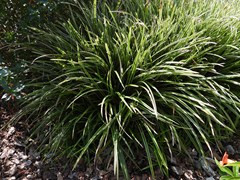Ice Dance Sedge (Carex ‘Ice Dance’) is a remarkable plant celebrated for its striking variegated foliage and versatility in shade gardens. Belonging to the sedge family (Cyperaceae), this cultivar of Carex is a standout choice for gardeners seeking low-maintenance groundcover with year-round visual appeal. Originating from the extensive Carex genus, which boasts over 1500 species thriving in diverse, often moist habitats globally, Ice Dance Sedge distinguishes itself with its ornamental qualities and adaptability.
 Close-up of Ice Dance Sedge variegated foliage, showcasing its white-edged green leaves
Close-up of Ice Dance Sedge variegated foliage, showcasing its white-edged green leaves
Key Features of Ice Dance Sedge
Ice Dance Sedge is admired for several key characteristics that make it a favorite among gardeners:
Foliage and Appearance
The most captivating feature of Ice Dance Sedge is its grass-like foliage. Each stiff leaf, reaching up to 12 inches long and approximately 1/2 inch wide, presents a vibrant contrast with dark green centers sharply defined by clean, white borders. This variegation provides a bright, illuminating effect, especially in shaded areas where color can be scarce. While technically deciduous in colder climates like St. Louis, it tends to retain some foliage color throughout winter, offering extended seasonal interest. In warmer regions, Ice Dance Sedge is evergreen, maintaining its attractive appearance throughout the year.
Growth Habit and Size
‘Ice Dance’ sedge exhibits a moderately spreading habit, distinguishing it from many clump-forming sedges. This spreading nature makes it an excellent choice for ground cover, capable of carpeting woodland areas effectively. It reaches a modest height of 0.75 to 1 foot and spreads to 1 to 2 feet, forming a dense, attractive mat of foliage.
Bloom Time and Flowers
Ice Dance Sedge produces brown, insignificant flowers from April to July. Like many ornamental grasses and sedges, the flowers are not the main attraction. The plant is primarily grown and loved for its decorative foliage, which provides visual interest throughout the growing season and beyond.
Cultivating Ice Dance Sedge
Cultivating Ice Dance Sedge is relatively straightforward, making it suitable for both novice and experienced gardeners.
Ideal Growing Conditions
This sedge thrives in part shade to full shade conditions, making it perfect for areas where many flowering plants struggle. While it prefers shade, it can tolerate closer to full sun if the soil is consistently kept moist. Ice Dance Sedge is adaptable to various soil types but flourishes in medium to wet, organically rich soils. It also performs well in average garden soils, showcasing its resilience.
Maintenance Tips
Maintenance for Ice Dance Sedge is minimal. It is recommended to cut back the foliage to the ground in late winter to refresh the plant for the new growing season. In colder zones, a winter mulch can be beneficial to protect the roots, although it is generally quite hardy in zones 5 to 9. Watering needs are medium to wet, ensuring the soil remains consistently moist, especially in sunnier locations.
Benefits and Uses of Ice Dance Sedge
Ice Dance Sedge is not only beautiful but also practical, offering several benefits and versatile uses in the garden.
Garden Applications
Due to its shade tolerance and spreading habit, Ice Dance Sedge is ideally suited for:
- Woodland Gardens: Its naturalizing ability makes it perfect for creating lush groundcover in woodland settings.
- Shade Gardens: It brightens up shady spots and complements other shade-loving plants like hostas.
- Border Fronts: Its manageable size and attractive foliage make it an excellent choice for edging borders.
- Rock Gardens: It adds textural contrast and visual interest in rock gardens, particularly in shaded sections.
- Rain Gardens: Tolerating wet soils, it’s a functional and attractive addition to rain gardens.
- Accent Plant: Use it as a striking accent in moist, shady areas to highlight specific garden features.
Ice Dance Sedge pairs beautifully with other shade-loving plants, particularly hostas, creating a tapestry of textures and shades in shady borders. Its preference for moist soil makes it a logical companion for plants with similar water requirements.
Problem Resistance
This sedge is known for its resilience and lack of significant problems. It is deer-resistant, a valuable trait in areas prone to deer browsing. It also tolerates heavy shade, erosion, and wet soil, making it a robust choice for challenging garden spots. Ice Dance Sedge is generally free from serious insect or disease issues, further contributing to its low-maintenance appeal.
Conclusion
Ice Dance Sedge is an exceptional choice for gardeners seeking a visually striking, easy-to-grow groundcover for shade gardens. Its variegated foliage brings light and contrast to darker areas, while its adaptability and low maintenance requirements make it a practical and beautiful addition to a variety of garden settings. Whether used to naturalize a woodland area, brighten a shady border, or add textural interest to a rock garden, Ice Dance Sedge is sure to enhance the beauty and appeal of any landscape. Consider incorporating this versatile and attractive sedge into your garden to enjoy its year-round charm.
